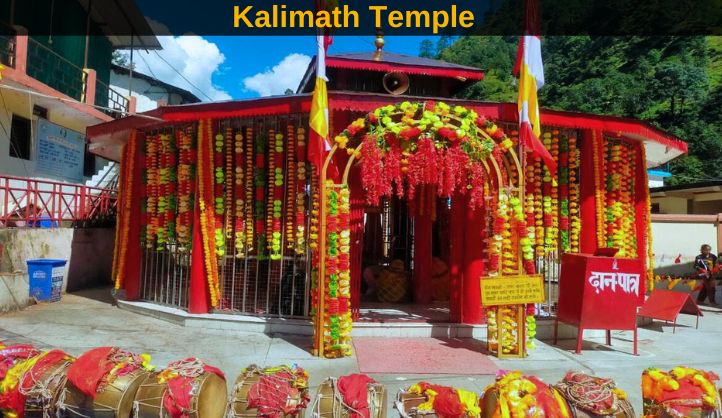About Kalimath
Kalimath, nestled in the lap of the majestic Himalayas, is a serene and spiritual destination located in the Rudraprayag district of Uttarakhand, India. The name “Kalimath” is derived from two words: “Kali,” referring to the fierce Hindu goddess Kali, and “Math,” meaning her temple. It is believed to be one of the significant Shakti Peethas, sacred sites where body parts of the goddess Sati fell during the cosmic dance of destruction.
Perched at an altitude of approximately 1,800 meters above sea level, this town is not just a picturesque hamlet but also a revered pilgrimage site. It is adorned with lush greenery, pristine streams, and the tranquil ambiance of the Himalayan wilderness, making it a perfect retreat for spiritual seekers and nature enthusiasts alike.
The highlight of this town is undoubtedly the ancient Kali temple, which is the focal point of devotion and religious activities in the region. The temple stands amidst a serene backdrop of towering peaks and dense forests, creating a mystical aura that captivates visitors. Devotees flock to Kalimath throughout the year, especially during the auspicious occasion of Navratri, a festival dedicated to the worship of the goddess Durga and her various forms, including Kali.
History
Throughout history, Kalimath Temple has remained a center of spiritual pilgrimage and devotion, attracting devotees from far and wide. The sanctity of the Kali temple and the divine aura surrounding Kalimath have drawn seekers of solace and blessings for centuries. The temple has undergone several renovations and enhancements over the years, yet it continues to preserve its ancient charm and spiritual essence.
Ancient Mythology and Legends
The history of Kalimath traces its roots back to ancient Hindu mythology, where it finds mention in various religious texts and epics. According to legend, Kalimath is believed to be one of the revered Shakti Peethas, sacred sites where body parts of the goddess Sati fell during the cosmic dance of destruction. It is said that the ancient Kali temple in Kalimath stands at the spot where the Goddess’s back is believed to have fallen, symbolizing her fierce aspect as the destroyer of evil.
Cultural Influence and Heritage
Kalimath’s history is intertwined with the cultural fabric of the region, reflecting the traditions, customs, and beliefs of the local communities. The Chaumasi fair, held every four months, is a testament to the cultural vibrancy of Kalimath, where devotees gather to celebrate and pay homage to the deities. The fair is marked by colorful processions, devotional music, and traditional rituals, providing a glimpse into the rich heritage of the area.
Modern Pilgrimages and Tourism:
In recent times, Kalimath has emerged as a popular destination for pilgrims, tourists, and adventure enthusiasts alike. The serene surroundings, coupled with the spiritual ambiance of the Kali temple, attract visitors seeking inner peace and rejuvenation amidst the Himalayan wilderness. Trekking expeditions, nature walks, and cultural experiences further enrich the modern-day pilgrimage to Kalimath, offering a holistic retreat for the mind, body, and soul.
Map of Kalimath Temple
How to Reach Kalimath
By Road:
- Kalimath is well-connected by roadways, with regular bus services and private taxis plying from major cities like Delhi, Dehradun, and Haridwar.
- From Delhi, one can take a bus or hire a taxi to reach Rudraprayag, the nearest town to Kalimath. From Rudraprayag, Kalimath is approximately 42 kilometers away, and local transport options like shared jeeps or taxis are available for the onward journey.
By Train:
- The nearest railway station to Kalimath is Rishikesh, located around 160 kilometers away. From Rishikesh, one can hire a taxi or board a bus to reach Rudraprayag, and then proceed to Kalimath by local transport.
By Air:
- The closest airport to Kalimath is Jolly Grant Airport in Dehradun, approximately 207 kilometers away. From the airport, one can hire a taxi or board a bus to reach Rudraprayag, and then continue the journey to Kalimath.
Things to Do in Kalimath: Exploring Spiritual and Natural Wonders
Visit the Kali Temple:
The primary attraction in Kalimath is the ancient Kali temple, dedicated to the fierce Hindu goddess Kali. Explore the intricate architecture of the temple and immerse yourself in the divine ambiance.
Attend the Evening Aarti:
Experience the soul-stirring evening aarti (prayer ceremony) at the Kali temple, where lamps are lit, hymns are sung, and devotees gather to offer their prayers to the goddess.
Journey to Kalishilla:
To reach Kalishilla, visitors embark on a spiritual journey through the rugged terrain and verdant landscapes surrounding Kalimath. The trek to Kalishilla is imbued with a sense of reverence and awe as pilgrims traverse through dense forests, meandering streams, and rocky pathways, eventually arriving at the sacred site nestled amidst the pristine Himalayan wilderness.
Explore the Surrounding Villages:
Take a leisurely stroll through the quaint villages surrounding Kalimath, where you can interact with the locals, learn about their way of life, and sample authentic Garhwali cuisine.
Photography and Birdwatching:
Capture the mesmerizing beauty of Kalimath and its surroundings through photography, with ample opportunities to capture stunning landscapes, colorful flora, and diverse bird species.
Relaxation and Meditation:
Unwind and rejuvenate amidst the serene ambiance of Kalimath, surrounded by the tranquil sounds of nature. Find a quiet spot for meditation or yoga, and reconnect with your inner self amidst the Himalayan serenity.
Attend Festivals and Fairs:
If your visit coincides with festivals like Navratri, immerse yourself in the vibrant celebrations, where music, dance, and religious fervor fill the air with joy and spirituality.
Nearby Places to Explore:
Rudraprayag:
Located approximately 13 kilometers away, Rudraprayag is a picturesque town situated at the confluence of the Alaknanda and Mandakini rivers. Visit the Rudranath and Chamunda Devi temples and take in the scenic beauty of the surrounding Himalayan landscape.
Kalishilla:
Kalishilla holds deep-rooted religious significance among devotees, serving as a sacred abode for spiritual seekers and pilgrims. The name “Kalishilla” is derived from two words: “Kali,” symbolizing the fierce Hindu goddess, and “Shilla,” referring to a sacred stone. Legend has it that Kalishilla is believed to be the spot where the divine presence of Goddess Kali resides in the form of a natural stone, emanating powerful vibrations of energy and spirituality.
Tungnath and Chandrashila:
Embark on a day trip to Tungnath, the highest Shiva temple in the world, located around 65 kilometers from Kalimath. From Tungnath, trek to Chandrashila, a vantage point offering panoramic views of the Himalayas.
Ukhimath:
Visit Ukhimath, around 15 kilometers away, known for its ancient temples and scenic beauty. The Omkareshwar temple and the winter abode of Kedarnath are among the notable attractions in Ukhimath.
Chaumasi :
Chaumasi in Kalimath emerges as a sacred sanctuary, steeped in spirituality and serenity. Situated in the Rudraprayag district of Uttarakhand, India, Chaumasi holds profound significance as a revered pilgrimage site and a haven for seekers of inner peace.
Conclusion:
In conclusion, this town stands as a beacon of spirituality and natural splendor in the heart of the Himalayas. Whether seeking solace in prayer, adventure in nature, or immersion in culture, this mystical destination offers an unforgettable experience for all who venture here. So, pack your bags, leave behind the hustle and bustle of the modern world, and embark on a soul-stirring journey to this town, where divinity meets the mountains in perfect harmony.
FAQs About Kalimath Temple
1. What is the significance of Kalimath in Hindu mythology?
This Place is believed to be one of the revered Shakti Peethas, where body parts of the goddess Sati fell during a cosmic dance. The ancient Kali temple in this town symbolizes this divine event, drawing pilgrims seeking blessings and solace.
2. How do I reach Kalimath?
This Place is accessible by air, with the nearest airport being Jolly Grant Airport in Dehradun, followed by a road journey. It can also be reached by train to Rishikesh or by road from major cities like Dehradun and Rishikesh.
3. What are the main attractions in Kalimath?
The primary attraction of this Place is the ancient Kali temple, revered for its spiritual ambiance and religious significance. Additionally, the Chaumasi fair, held every four months, is a vibrant celebration of faith and devotion.
4. What activities can I engage in while visiting this town?
Visitors to Kalimath can engage in various activities such as visiting the temple, participating in religious rituals, trekking through the surrounding Himalayan trails, and exploring nearby attractions like Deoria Tal and Tungnath.
5. When is the best time to visit Kalimath?
The best time to visit this town is during the summer months from April to June and the post-monsoon season from September to November when the weather is pleasant and conducive for outdoor activities and pilgrimage. Additionally, the Navratri festival in October is a popular time to visit for cultural festivities and spiritual experiences.





